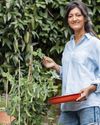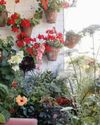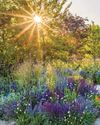
If you want to find one word to make most gardeners smile, just say bulbs. It is a magical word conjuring up a thousand pictures – and all of them in glorious technicolour. No other group of plants sets the heart racing and the imagination whirring more than bulbs. Their other attraction is that they are so rewarding – dig a hole, drop in your bulb, forget about it then in a few months’ time rejoice when suddenly fat buds burst into a flurry of colour. Their show is spectacular and, though it may not be prolonged, with a little thoughtful planning a succession of different bulbs can be used to bring colourful variety to beds and borders, balconies and patios and shady corners. If you don’t already grow bulbs that flower in summer’s dog days, you simply don’t know what you are missing. There’s a world of treats waiting to be explored that will delight your senses, attract pollinators and bring pizazz and panache to your summer borders.
The tradition of planting bulbs in autumn that will flower in spring is long established. It is part of our gardening DNA. Daffodils, tulips and a host of other bulbs are planted and enjoyed in their millions, but summer-flowering bulbs are less appreciated. Perhaps it is to do with spring bulbs arriving at a time when our gardens are comparatively stark, their colour and jollity announcing the beginning of the gardening year. By summer, though, the garden party is in full swing and there is all-round competition.
Rather than detract from, or vie with the flowers of June, July and August, summer bulbs introduce more depth, more excitement, a whole new dimension.
Denne historien er fra March 2022-utgaven av Gardeners World.
Start din 7-dagers gratis prøveperiode på Magzter GOLD for å få tilgang til tusenvis av utvalgte premiumhistorier og 9000+ magasiner og aviser.
Allerede abonnent ? Logg på
Denne historien er fra March 2022-utgaven av Gardeners World.
Start din 7-dagers gratis prøveperiode på Magzter GOLD for å få tilgang til tusenvis av utvalgte premiumhistorier og 9000+ magasiner og aviser.
Allerede abonnent? Logg på

A new plot for tasty crops
Taking on a new allotment needn't be hard work. By simply following a few easy tips you can have bumper crops in no time, just like Alessandro Vitale

We love July
July is an island floating between the joy of June and the slightly fatigued month of August. It's a grown-up month: the year has shrugged off its adolescent exuberances, the weather is (hopefully) warm enough for ice cream to be one of your five a day, the sea should be swimmable without (too much) danger of hypothermia and thoughts will be of holiday shenanigans and family barbecues. School's out this month, the next tranche of glorious summer colour is washing across our borders and it's my birthday. Lots of reasons to give three rousing cheers for July!

YOUR PRUNING MONTH
Now, at the height of summer, Frances Tophill shows how to boost your plants' health and productivity with a timely cut

Hassle-free harvests
Flowers are out in abundance this month and for Jack Wallington, many of these blooms make delicious, low-effort pickings

Bite-sized bounties
Glorious doorstep harvests can easily turn into gluts, so let Rukmini Iyer's recipes help you savour every last bit

Upcycled outdoor living
Create unique and stylish garden features for minimal cost using reclaimed materials and simple DIY skills. Helen Riches shares four step-by-step projects and more inspiring eco tips

Secrets of a COLOURFUL GARDEN
Buildings and landscapes can play a vital role in supercharging your space, as Nick Bailey demonstrates

Greening up a city balcony
Looking for sustainable, small-space gardening ideas? Take inspiration from Oliver Hymans' transformed balcony garden in north-east London - now a lush, green haven for humans and wildlife

The dry and mighty garden
As we adapt our gardens to a more volatile climate, Alan Titchmarsh reveals how to create a drought-tolerant plot and picks his top plant performers

Nature knows best
Carol Klein explains how to choose plants for specific growing conditions, based on what has naturally adapted to thrive there